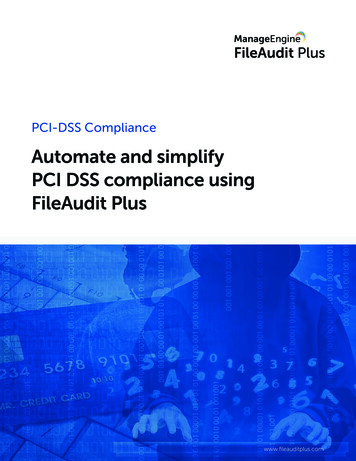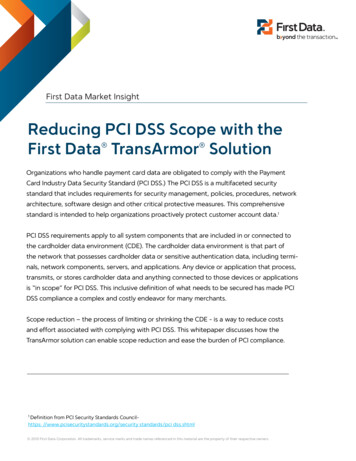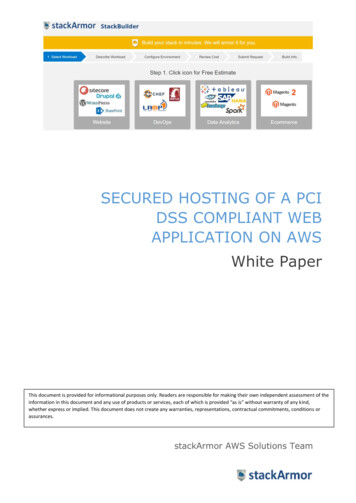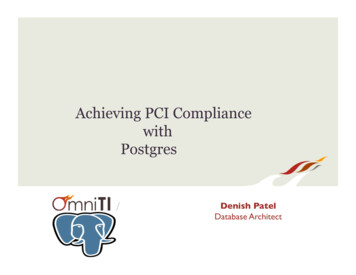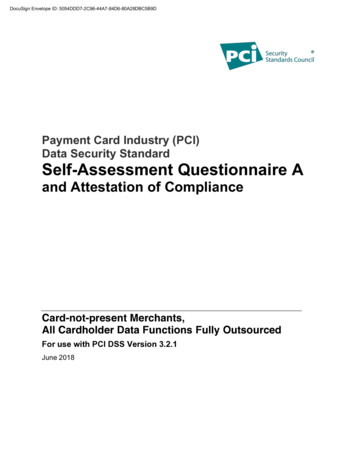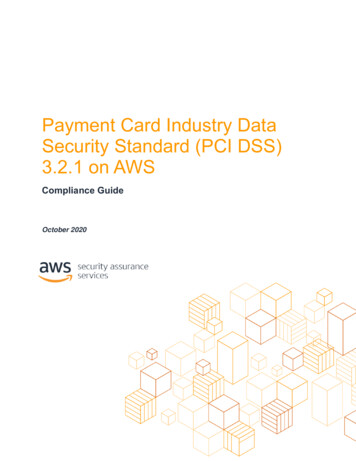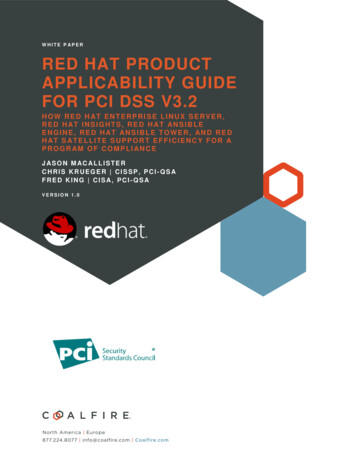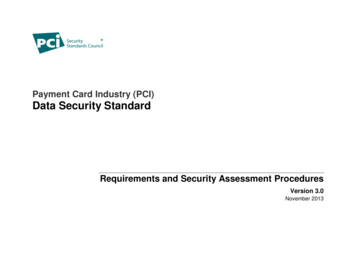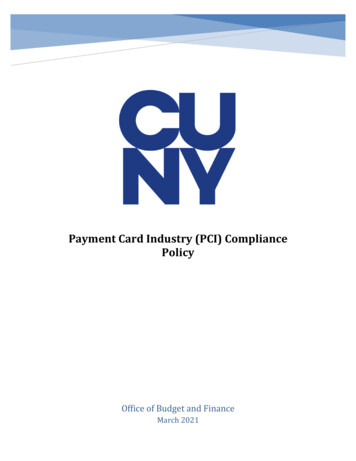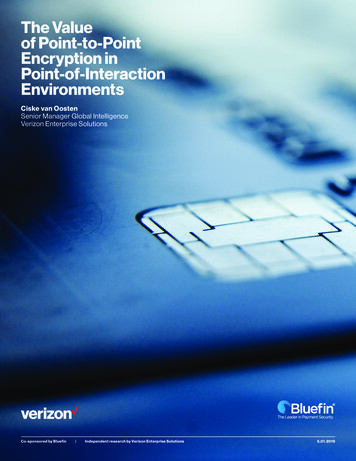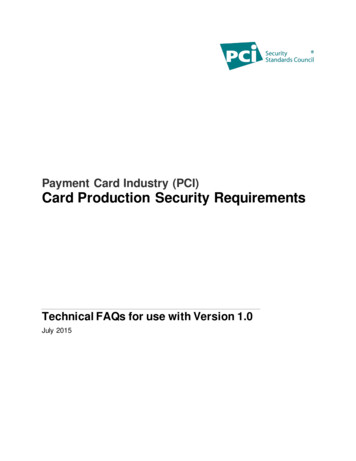
Transcription
Payment Card Industry (PCI)Card Production Security RequirementsTechnical FAQs for use with Version 1.0July 2015
Table of ContentsLogical Security Requirements . 2General Questions .2Section 1 – Scope.2Section 2 – Roles and Responsibilities .2Section 3 – Security Policy and Responsibilities.2Section 4 – Data Security .2Section 5 – Network Security .4Section 6 – System Security .7Section 7 – User Management and System Access Controls .7Section 8 – Key Management: Secret Data .8Section 9 – Key Management: Confidential Data . 10Section 10 – PIN Distribution via Electronic Methods. 10Physical Security Requirements. 11General Questions . 11Section 2 – Personnel . 11Section 3 – Premises . 13Section 4 – Production Procedures and Audit Trails . 20Section 5 – Packaging and Delivery Requirements . 23PCI Card Production Security Requirements – Technical FAQs for v1Copyright 2013-2015 PCI Security Standards Council LLCJuly 2015Page i
Logical Security RequirementsThese technical FAQs provide answers to questions regarding the application of the Payment CardIndustry (PCI) Logical Security Requirements. These FAQs provide additional and timely clarifications tothe application of the Security Requirements. The FAQs are an integral part of those requirements andshall be fully considered during the evaluation process.Updates: New questions or those modified for clarity are shown in red.General QuestionsQ1October 2014 - If a Chip Card manufacturer sets up a remote personalization servicewithin an Issuer, is the Issuer facility required to be PCI Card Production compliant?A If a third party (vendor) sets up and operates a personalization service inside an issuer'spremises then the issuer facility is required to be approved. If the service is operated by theissuer so that only the issuer has access to card stocks, cardholder data and keys then it isnot required to be approved. For further information regarding details of who is responsiblefor ensuring the compliance of the facility, contact the payment brand(s) of interest.Section 1 – ScopeNo FAQ in this section – Reserved for future use.Section 2 – Roles and ResponsibilitiesNo FAQ in this section – Reserved for future use.Section 3 – Security Policy and ResponsibilitiesNo FAQ in this section – Reserved for future use.Section 4 – Data Security4.1.2 Confidential Data4.1.2.a Confidential data is data restricted to authorized individuals. This includes cardholder data andthe keys used to encrypt cardholder data. These are confidential data and must be managed inaccordance with Section 9 of this document, “Key Management: Confidential Data.”Q2December 2013 – Confidential data is defined to include PAN, expiry date, service code,and cardholder name. Does this apply to all these data elements individually or in anycombination?A The PAN must always be considered confidential, and the other three data elements areconsidered confidential if stored or otherwise available in conjunction with the PAN.PCI Card Production Logical Security Requirements – Technical FAQs for v1Copyright 2013-2015 PCI Security Standards Council LLCJuly 2015Page 2
4.2 EncryptionAll secret and confidential data must be:a) Encrypted using algorithms and key sizes as stated in Normative Annex A.b) Encrypted at all times during transmission and storage.c) Decrypted for the minimum time required for data preparation and personalization.d) The vendor must only decrypt or translate cardholder data on the data-preparation or personalizationnetwork and not while it is on an Internet or public facing network.Q3October 2014 - Does transmission include the file movement between the systems onthe data-preparation or personalization or does it apply only to data that is transmittedbetween organizational entities over a public network?A If the data is going from one system or server to another then it is being transmitted andmust be encrypted. It does not matter if the networks are not internet or public facing. Theintention is that data is in clear only in memory for the minimum time required for processing.4.7 Contactless Personalization4.7 The security requirements for dual-interface cards that are personalized using the contact interfaceare the same as for any other chip card. The requirements in this section apply to personalization ofchip cards via the contactless NFC interface.The vendor must:a) Ensure personalization signals cannot be detected beyond the HSA.b) Conduct a scan of area surrounding the HSA whenever the personalization environment ischanged to confirm personalization data sent by wireless communication does not reach beyondthe HSA.c) Ensure that when personalization signals are encrypted, they comply with the encryption standardsdefined in Normative Annex A.d) Perform a manual or automated inspection of the secure personalization area at least twice eachmonth in order to detect any rogue radio-frequency (RF) devices.e) Ensure that personalized cards (including rejects) are stored and handled as batches of two ormore cards or enclosed within protective packaging that restricts reading card emissions until thecards are packaged for final distribution or destruction.Q4July 2014 - Do all the requirements of 4.7 apply when the personalization data isencrypted prior to sending it to the cardA This requirement is under revision. If 4.7 c is met then a, b, d need not apply.PCI Card Production Logical Security Requirements – Technical FAQs for v1Copyright 2013-2015 PCI Security Standards Council LLCJuly 2015Page 3
Section 5 – Network Security5.2 General RequirementsThe vendor must:a) Maintain a current network topology diagram that includes all system components on the network.b) Ensure the network topology diagram is reviewed, updated as appropriate, and verified at least onceeach year and whenever the network configuration is changed.c) Ensure that the CISO accepts, by formal signature, the security implications of the current networktopology.d) Ensure that the personalization and data-preparation systems are on dedicated network(s)independent of the back office (e.g., accounting, human resources, etc.) and Internet -connectednetworks. A virtual LAN (VLAN) is not considered a separate network.e) Put controls in place to restrict, prevent, and detect unauthorized access to this network. Access fromwithin the high security area to anything other than the personalization network must be “read-only.”f)Be able to immediately assess the impact if any of their critical nodes are compromised.g) Have controls in place to restrict “write” permission to any system external to the personalizationnetwork to only pre-approved functions that have been authorized by the VPA. These write functionsmust not transmit cardholder data.h) Control at all times the physical connection points leading into the personalization network.i)Prevent data from being tampered with or monitored by protecting the network cabling associatedwith personalization-data movement.j)Transfer required issuer data and keys into the personalization network via a defined anddocumented process.k) Ensure a process is in place for updates and patches and identification of their criticality, as detailedin Section 6.3.Q5October 2014 - Access from within the high security area to anything other than thepersonalization network must be read-only. If the data preparation network is also in thehigh security area, can the personalization network write to the data preparationnetwork?A Yes, if they are separate networks then generally the data preparation network will depositfiles for production on the personalization network or the personalization network will readthem from the data preparation network. It’s not a problem as long as they are both in thesame HSA. If they are in separate HSAs, the communication path must conform to the DMZsecurity.Q6October 2014 - Controls must be in place to restrict write permission to any systemexternal to the personalization network to only pre-approved functions that have beenauthorized by the VPA and these write functions must not transmit cardholder data. Ifthe data preparation and personalization networks are separate, can the datapreparation network have write permissions to a corporate network?A No, the data preparation network must meet the same requirements as the personalizationnetwork, data preparation is simply the first step in personalizationPCI Card Production Logical Security Requirements – Technical FAQs for v1Copyright 2013-2015 PCI Security Standards Council LLCJuly 2015Page 4
Q7October 2014 - Inventory and order systems may reside in the HSA on the datapreparation and personalization networks. Corporate users may require access to theinventory and order detail updates performed on those systems. However, logicalaccess from outside the HSA to these networks is not allowed, and access from withinthe HSA to anything other than the personalization network must be read-only How canthe corporate users obtain access to this information?A The information needs to be transferred out of the HSA using an approved process via theDMZ, just like cardholder return files, etc. Direct write from the system containing theinformation is not permitted.5.6Remote Access5.6.1 Connection Conditions5.6.1.j The vendor must ensure that all remote access locations are included in the facility’s complianceassessment and meet these requirements.Q8July 2013 – Remote access is permitted only for administration of the network or systemcomponents and is not permitted to any system where clear-text cardholder data isbeing processed. If system administration is handled remotely by the card vendor oroutsourced to a third party, are they still subject to the criteria defined within the RemoteAccess Section?A Yes, administration of the network and system components is a critical activity that requiresa secure environment that complies with the defined security requirements and is audited forcompliance.5.6.2Virtual Private Network (VPN)5.6.2.a Remote access is permitted only for the administration of the network or system components.Q9December 2013 – Section 5.6.2 stipulates criteria that VPNs must meet. Under whatcircumstances does this criteria apply, and is there differentiation between mobile VPNsand site-to-site VPNs?A The VPN requirements are part of the Remote Access requirements in Section 5.6.Therefore, they apply to the remote administration of networks and system components thatcomprise the HSA and do not apply to VPNs that are used for other purposes. For example,the VPN requirements apply to administration of the personalization network and do notapply to VPNs used for conveyance of issuer data to the card vendor.PCI Card Production Logical Security Requirements – Technical FAQs for v1Copyright 2013-2015 PCI Security Standards Council LLCJuly 2015Page 5
5.75.7.1Wireless NetworksGeneralThe vendor must:a)Implement a policy regarding wireless communications and clearly communicate this policy to allemployees.b)Not use wireless communications for the transfer of any personalization data.c)Identify, analyze, and document all connections. Analysis must include purpose, risk assessment,and action to be taken.d)Use a scanning device that detects hidden networks, as well as wireless intrusion detectionsystems (WIDS)—fixed and/or mobile—that will detect hidden and spoofed networks.e)Use a WIDS to conduct random monthly wireless scans within the HSA to detect rogue andhidden wireless networks.Q 10 October 2014 - Requirement 5.7.1.d requires that a scanning device is used to detecthidden networks, and the use of a wireless intrusion detection network to detect hiddenand spoofed networks. If a vendor does not have a wireless network, do they still needto comply?A This requirement is under revision. Yes, the vendor must still use a scanning device that iscapable of detecting rogue and hidden wireless networks. Random scans of the HSA mustbe conducted at least monthly.5.8Security Testing and Monitoring5.8.1VulnerabilityThe vendor must:a) Perform quarterly external vulnerability scans using an Approved Scanning Vendor (ASV) approvedby the Payment Card Industry Security Standards Council (PCI SSC).b) Perform internal and external vulnerability scans after any significant change. Scans after changesmay be performed by internal staff.c) Ensure all findings from vulnerability scans are prioritized and tracked. Corrective action for highpriority vulnerabilities must be started within two working days.d) Retain evidence of successful remediation and make this evidence available during site complianceevaluations upon request.Q 11 October 2014 - Is an internal vulnerability scan only required when there has been achange and no longer each quarter?A This requirement is under revision. Because of evolving threat vectors, both external andinternal network vulnerability scans must occur at least quarterly, as well as after anysignificant change in the network (such as new system component installations, changes innetwork topology, firewall rule modifications, product upgrades). Scans after changes maybe performed by internal staff.PCI Card Production Logical Security Requirements – Technical FAQs for v1Copyright 2013-2015 PCI Security Standards Council LLCJuly 2015Page 6
Section 6 – System Security6.1General Requirements6.1.fThe vendor must ensure that virtual systems do not span different network domains.Q 12 December 2013 – For purposes of this requirement, how are network domains definedfor what is allowed or not allowed?A In a virtualized environment, activities involving data preparation and personalization can usethe same equipment. However, you cannot use the same equipment for systems in the DMZand data-preparation or personalization area. This is because data preparation andpersonalization must occur within the HSA, whereas other activities must occur outside theHSA.6.3Configuration and Patch Management6.3.jThe vendor must implement critical patches within two business days. When this is not possiblethe CISO, security manager, and IT director must clearly record that they understand that acritical patch is required and authorize its implementation within a maximum of seven businessdays.Q 13 December 2013 – Is there any dispensation from this requirement?A This requirement is under revision. Meanwhile, the need to patch within seven business daysapplies to all Internet-facing system components. Otherwise the maximum is thirty days, andstill requires the proper sign-offs.Section 7 – User Management and System Access Controls7.2.2 Password – Characteristics and Usage7.2.2.c The vendor must ensure “first use” passwords expire if not used within 24 hours of dis tribution.Q 14 December 2013 – Some systems are not capable of expiring passwords within 24 hoursas required by 7.2.2.c. What alternatives are available?A If a system cannot expire initial passwords that are not used within 24 hours of distribution,then the passwords must not be issued more than 24 hours before expected use. If 24 hourselapses without use, they must be manually expired within that 24-hour period.7.4Account Locking7.4.cLocked accounts must only be unlocked by the security administrator.Q 15 December 2013 – Are other mechanisms available to meet this requirement?A This requirement is under revision. Meanwhile, user accounts can also be unlocked viaautomated password reset mechanisms. Challenge questions with answers that only theindividual user would know must be used. These questions must be designed such that theanswers are not information that is available elsewhere in the organization, such as in theHuman Resources Department.PCI Card Production Logical Security Requirements – Technical FAQs for v1Copyright 2013-2015 PCI Security Standards Council LLCJuly 2015Page 7
Section 8 – Key Management: Secret Data8.4.1 General Requirements8.4.1.a) The vendor must define procedures for the transfer of key-management roles betweenindividuals.Q 16 July 2015: The vendor must define procedures for the transfer of key-management rolesbetween individuals. Does "roles" mean custodian A holder versus a custodian Bholder?A No. This is not intended for transfer of roles between existing custodians if it results in acustodian collectively having access to sufficient key components or shares of a secret orprivate key to reconstruct a cryptographic key.For example, in an m-of-n scheme (which must use a recognized secret-sharing schemesuch as Shamir), where only two of any three components are required to reconstruct thecryptographic key, a custodian must not have current or prior knowledge of more than onecomponent. If a custodian was previously assigned component A, which was thenreassigned, the custodian must not then be assigned component B or C, as this would givethem knowledge of two components, which gives them ability to recreate the key.8.4.2 Key Manager8.4.2.e) The Key Manager must be responsible for ensuring that:i.All key custodians have been trained with regard to their responsibilities, and this formspart of their annual security training.ii.Each custodian signs a statement, or is legally bonded, acknowledging that theyunderstand their responsibilities.Key custodians who form the necessary threshold to create a key must not report directly to thesame manager.Q 17 July 2014 - If the key manager is also a key custodian, can other key custodians reportto the key manager?A Other key custodians must not report to the key manager if in conjunction with the keymanager that would form a threshold to create a key.8.6Key Distribution8.6.dKey components or shares must only be received by the authorized custodian, who must inspectand ensure that no one has tampered with the shipping package.Q 18 December 2013 – Are there any alternatives to meet this requirement for when theauthorized custodian is unavailable?Yes, if the primary custodian is unavailable, a pre-designated and authorized backupcustodian can receive the package. Alternatively, drop boxes can be used for the courier toleave the package in a locked container that is only accessible by the primary and backupcustodians.PCI Card Production Logical Security Requirements – Technical FAQs for v1Copyright 2013-2015 PCI Security Standards Council LLCJuly 2015Page 8
8.8Key Storagee) Ensure that access logs include, at a minimum, the following:i. Date and time (in/out)ii. Names of key custodians involvediii. Purpose of accessiv. Serial number of envelopeQ 19 October 2014 - What specifically is the requirement regarding the signature of acustodian being placed on the access logs? Does it require the full name (first and last)or can the signature be first initial and last name or only be the initials of thecustodians?A Signatures must be sufficient to identify each custodian. Full names or initials or anycombination are acceptable as long as it can be positively affirmed who provided thesignature.8.9Key Usage8.9.aEach key must be used for only one purpose and not shared between payment systems, issuersor cryptographic zones, for example:8.9.bTransport keys used to encrypt other keys for conveyance (e.g., KEK, ZCMK) must be unique perestablished key zone and, optionally, unique per issuer within that zone. These keys must only beshared between the two communicating entities and must not be shared with any thirdorganization.Q 20 July 2014 –Can vendor and issuer keys exist at another site, such as for subcontractedcard production activities, or for disaster recovery purposes?A Copies of keys at another site (e.g. Issuer keys or personalization keys) may exist if there isa contract with that site e.g., if they are subcontracting the personalization activity to that site.This subcontracting needs the written permission of the issuer(s) impacted.For disaster recovery purposes, the same conditions apply. There must be a contract inplace with the disaster recovery site and written permission of the issuer(s) impacted. Theseconditions apply whether the other site is operated by the vendor or by a third party.Outside of the aforementioned conditions, the only storage that can be outside the HSA oroffsite is of encrypted keys.However, copies of the HSM’s master file key cannot exist off site in any scenario. Storageof keys is a personalization activity so it must take place in the HSA, i.e. at the approved site.Custodians must be employees of the company i.e. not employees of another vendor.Q 21 July 2013 – Can the same transport keys be used between the card vendor and separatelocations of another organization?A No, each location would constitute a separate key zone and therefore different transportkeys must be used. The same is true for a card vendor with multiple locationscommunicating to one or more locations of another organizational entity.PCI Card Production Logical Security Requirements – Technical FAQs for v1Copyright 2013-2015 PCI Security Standards Council LLCJuly 2015Page 9
8.9.gIC keys must be unique per IC.Q 22 December 2013 – Does 8.9.g apply to all IC keys?A No, it does not apply to manufacturer or founder keys. It does apply to other keys such asthose used for pre-personalization.8.14 Key-Management Security Hardware8.14.c HSMs used for key management or otherwise used for the protection of sensitive data must beapproved by PCI or certified to FIPS 140-2 Level 3, or higher.Q 23 July 2014 – Does the HSM FIPS/PCI certification include customization of native HSMfirmware if the FIPS/PCI mode is not impacted.A If firmware is modified it impacts the approval. However, HSMs may allow customers orintegrators to install additional applications where the vendor can show that by permittingthis: It cannot adversely affect the security features of the product that are relevant to the PCIHSM certification. It cannot modify any of the cryptographic functionality of the HSM or introduce newprimitive cryptographic functionality. The application is strongly authenticated to the HSM by digital signature. The application does not have access to sensitive keys.Applications, in this context, are functional entities that execute within the boundary of theHSM and may or may not provide services external to the HSM. Applications are typicallyprocesses or tasks that execute under the control of an Operating System (OS) or softwareexecutive routine.Applications are considered to be separated by access rights. OS/firmware is considered allcode, which is responsible to enforce, manage, or change such access rights.Section 9 – Key Management: Confidential DataNo FAQ in this section – Reserved for future use.Section 10 – PIN Distribution via Electronic MethodsNo FAQ in this section – Reserved for future use.PCI Card Production Logical Security Requirements – Technical FAQs for v1Copyright 2013-2015 PCI Security Standards Council LLCJuly 2015Page 10
Physical Security RequirementsThese technical FAQs provide answers to questions regarding the Payment Card Industry (PCI) CardProduction Physical Security Requirements. These FAQs provide additional and timely clarifications tothe application of the Security Requirements. The FAQs are an integral part of those requirements andshall be fully considered during the evaluation process.Updates: New or questions modified for clarity are in red.General QuestionsNo FAQ in this section – Reserved for future use.Section 2 – Personnel2.1.3.1 Employment Application Forms2.1.3.1.b The vendor must maintain a personnel file for each employee that includes but is not limited tothe following information: Gathered as part of the hiring process: Background check resultsVerification of aliases (when applicable) List of previous employers and referral follow-up resultsEducation historySocial security number or appropriate national identification numberSigned document confirming that the employee has read and understands thevendor’s security policies and procedures Fingerprints and results of search against national and regional criminal records Gathered as part of the hiring process and periodically thereafter:Q1 Current photograph, updated at least every three years Record of any arrests or convictions, updated annuallyAnnual credit checksDecember 2013 – Drug testing is not required in the PCI Card Production SecurityRequirements. Is this an oversight?A No, PCI does not require drug testing due to the wide variances in country laws governingwhere or when drug testing is allowed. However, that does not preclude card vendors fromrequiring drug testing wherever and whenever they deem necessary.Q2July 2013 – Requirement 2.1.3.1 requires annual credit checks. In some countries, only asmall fraction of the employees have ever had a credit transaction, so the local creditbureau does not have any record of them. What should happen in these cases?A The intent of the requirement is to determine whether the person is under any financi alduress that should be considered for their employment. Even if the credit check is expectedto not show anything, it still must be attempted. If the person does not have a credit history,the vendor should apply alternative procedures as the vendor deems appropriate in order tofulfill the intent of this requirement.PCI Card Production Physical Security Requirements – Technical FAQs for v1Copyright 2013-2015 PCI Security Standards Council LLCJuly 2015Page 11
Q3July 2015: Does the card vendor have to use fingerprints to conduct a search againstcriminal records as part of the background check process?A A criminal background search must be conducted. That search may use fingerprints or anyother method or means of identification.External Service Providers – General Guidelines2.4.12.4.1.a The vendor must ensure that the requirements of Section 2.1, “Employees,” of this documenthave been met by the employer of all suppliers, repair and maintenance staff, and any otherexternal service provider.Q4December 2013 – Requirement 2.4.1 states that all third-party service providers (forexample, suppliers, repair and maintenance staff, and any other external serviceproviders) must meet the same requirements as employees of the card vendor who haveaccess to card products, components, and the high security area (HSA). This includespre-employment testing, screening, training, termination checks, etc. Does the cardvendor have to directly conduct these reviews?A No. The intent of this objective is to ensure that service provider employees with access tothe HSA conform to the same employment screening criteria as staff employed by thevendor. As noted in Requirement 2.4.1, the employer of these third-party service providersshould conduct the necessary reviews. The card vendor meets this requirement by eitherdirectly performing the review or by contractually obligating the third-party external serviceprovider to conduct these reviews.Vendor Agents – General Guidelines2.5.12.5.1.a Prior to conducting any business with an agent or third party regarding card-related activities, thevendor must register the agent with the VPA and obtain the following information:Q5 Agent’s name, address, and telephone numbers Agent’s role or responsibilityJuly 2014 – In the context of this requirement, what are card-related activities and whatactivities are allowed for agents or third parties?A Card related activities such as sales and marketing activities are allowed. Agents and thirdparties must never produce, own or handle cards.PCI Card Production Physical Security Requirements – Technical FAQs for v1Copyright 2013-2015 PCI Security Standards Council LLCJuly 2015Page 12
Section 3 – Premises3.1 External Structure3.1.1 External Constructiona) The vendor must prevent unauthorized access to buildings, building areas, or structures containingtechnical machinery or equipment such as the heating system generator, auxiliary power supply, andair conditioning.Q6October 2014 - If a facility has a fence around the whole property, is a separate fence stillrequired around the technical machinery?A Yes, separate access controls are still required. There will be many people who will haveaccess beyond the fence (everyone entering the facility) but who will not be authorized toaccess the machinery nor do they need to have access to the technical machinery. Ingeneral
Q 1 October 2014 - If a Chip Card manufacturer sets up a remote personalization service within an Issuer, is the Issuer facility required to be PCI Card Production compliant? A If a third party (vendor) sets up and operates a personalization service inside an issuer's premises then the issuer facility is required to be approved.
